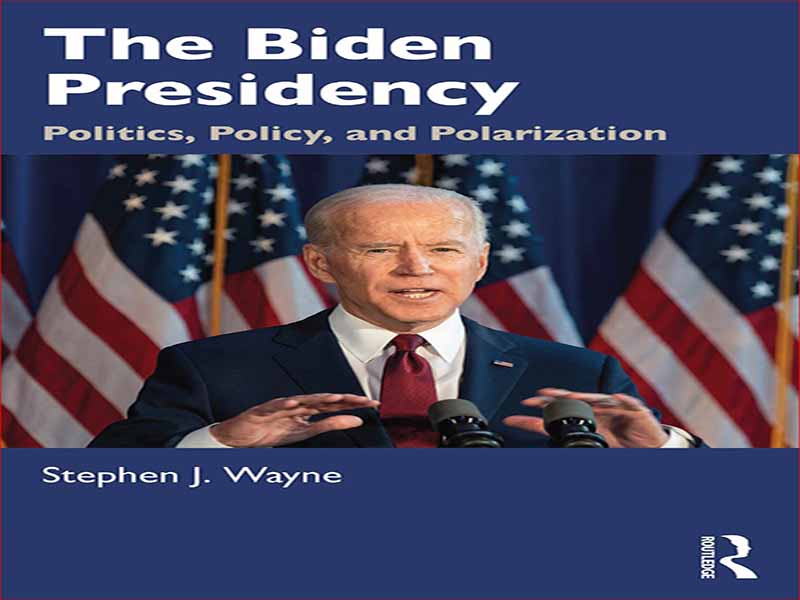- عنوان کتاب: THE BIDEN PRESIDENCY / POLITICS, POLICY, AND POLARIZATION
- نویسنده: STEPHEN J. WAYNE
- حوزه: مطالعات آمریکا
- سال انتشار: 2022
- تعداد صفحه: 226
- زبان اصلی: انگلیسی
- نوع فایل: pdf
- حجم فایل: 10.6 مگابایت
این کتاب عمدتاً شرح و تحلیل 18 ماه اول ریاست جمهوری بایدن است. پیامدهای انتخابات 2020 برای بایدن را خلاصه می کند، انتقال را بررسی می کند و عملکرد دولت او را در مقام ارزیابی می کند. همچنین در مورد محیط خارجی که او مجبور بود به آن رسیدگی کند اما نتوانست آن را کنترل کند بحث می کند. مسائل مستمر و پیشبینیشدهای که ممکن است پرزیدنت بایدن با آنها سر و کار داشته باشد نیز مورد توجه قرار گرفته است.
سازماندهی متن در فهرست مطالب ظاهر می شود. شش کادر وجود دارد که رویدادها، مشکلات، پیشنهادات خط مشی و قوانین وضع شده توسط یک یا هر دو مجلس کنگره 117 را شرح می دهد. 11 کپسول کوچک که مواضع و فعالیتهای سیاسی حزبی بایدن و ترامپ و موفقیتها و شکستهای آنها را مقایسه و مقایسه میکند. 17 جدول و یک ضمیمه حاوی داده های کمی و توصیفی و همچنین نمودارهای سازمانی بخش های دفتر اجرایی رئیس جمهور و 14 عکس.
بخش اول خلاصه ای از فعالیت های بایدن قبل از ریاست جمهوری است. فصل 1 بر انتخابات ریاست جمهوری 2020 تمرکز دارد و وعده های انتخاباتی بایدن، حمایت انتخاباتی و استراتژی هایی را که برای پیروزی به کار برد، شرح می دهد. فصل 2 جزئیات انتقال او به قدرت را نشان می دهد: چگونه او بر مقاومت سلف خود در برابر الزامات قانون گذار ریاست جمهوری 1963 غلبه کرد که نمایندگان بایدن را از ملاقات با مقامات دولتی به مدت سه هفته و در برخی موارد حتی بیشتر جلوگیری کرد. این فصل همچنین چگونگی سازماندهی انتقال بایدن و مشاورانش را توضیح می دهد. با فشارهای داخلی دموکرات ها برای معرفی نامزدهای خاص برای منصب مقابله کرد. با انتصاب بیشتر زنان، رنگین پوستان و اقلیت های قومی به تنوع دست یافت. و اولویت ها را برای دستور کار سیاست داخلی خود تعیین کند. در طول دوره انتقال، دستیاران ارشد بایدن نیز ده روز اول ریاست جمهوری او را برنامه ریزی و سازماندهی کردند. چیز کمی به شانس سپرده شد.
بخش دوم 100 روز اول بایدن را بررسی میکند: اهداف سیاست داخلی او، استراتژی که برای تعامل با کنگره اتخاذ کرد، و موفقیتها و شکستهای او در دستیابی به بخشی از دستور کار سیاسیاش. فصل 3 به چگونگی برنامه ریزی و سازماندهی ده روز اول او می پردازد: آنچه رئیس جمهور تلاش کرد انجام دهد، ابتکارات قانونی و اقدامات اجرایی او، و ارزیابی عملکرد او در این دوره توسط مردم آمریکا.
فصل 4 به سیاست حزبی و روابط ریاست جمهوری و کنگره می پردازد. این بخش زمینههای تعارض و همکاری بین و درون احزاب، مصالحههایی که برای به دست آوردن حمایت کافی برای اجرای اهداف سیاست بایدن، دستاوردها و شکستهای اولیه قانونگذاری رئیسجمهور، و دستور کار پیش رو را بررسی میکند. فصل پنجم به رویکرد او در امور خارجی، تاکیدات جغرافیایی دولتش، روابط دیپلماتیک مستمر، و چارچوبی که بایدن برای شکل دادن به سیاست خارجی متفاوت از سیاست های قبلی خود استفاده کرد، می پردازد. افرادی که برای هدایت خط مشی او انتخاب شدهاند، سازمانهایی که رهبری میکنند و روابط آنها با همتایان خود از کشورهای دیگر، دوستان و دشمنان، نیز شرح داده شده است.
بخش سوم روابط بایدن با نهادهای اصلی دولت ملی آمریکا: کنگره، قوه مجریه و نظام حقوقی را شرح می دهد. فصل اول کنگره، فصل 6، به مشکلاتی میپردازد که رئیسجمهور و حزب کنگرهاش در کنگرهای متنوع، تا حدودی ناسازگار، از نظر ایدئولوژیک دو قطبی شده و به شدت تقسیمشده با آن مواجه بودند. همچنین در مورد مشکلات نهادی و شخصی بایدن در برخورد با دو نهاد قانونگذاری متمایز و همچنین در مورد منیت های بزرگ و انگیزه های اصلی اعضای کنگره در هنگام بررسی و رای دادن به قانون، انتخاب مجدد آنها، اعتقادات شخصی و نیاز به جلب رضایت افرادی که به آنها رای داد، نه غیر رای دهندگان یا مخالفان سیاسی. این فصل همچنین محدودیتها و فرصتهای اعمال قدرت ریاستجمهوری، استراتژیهایی را که میتوان برای گسترش آن قدرت استفاده کرد، و روشی که رئیسجمهور اولین اولویت اصلی قانونی خود، قانون طرح نجات آمریکا در سال 2021 را دنبال کرد، بررسی میکند. سبک شخصی بایدن، شیوههای تعامل، مسائل اصلی قانونگذاری که سیاستگذاران را از هم جدا کرده و نقش کاخ سفید در برخورد با کنگره و بسیج فشار عمومی بر آن نیز مورد بحث قرار گرفته است. فصل 7 نتایج قانونگذاری، چگونگی و چگونگی سازش ها، نقش رئیس جمهور در مذاکره با آنها، و پیشنهادات موجود در لوایح نهایی را که تصویب، تا حدی موفق، با تأخیر یا شکست خورده اند، شرح می دهد. همچنین به قوانین مهم دیگری که در قانون وضع شده است اشاره می کند.
در فصل 8، سازمان، عملیات، و دستیاران اصلی انتخاب شده برای مناصب ارشد کاخ سفید و مقامات ارشد اجرایی و تصاویر طراحی شده برای تضاد با ریاست جمهوری بایدن با ترامپ، مشکلاتی که در دولت سلف او به وجود آمد و بایدن می خواست از آنها اجتناب کند، به تفصیل توضیح داده شده است. رفتار حرفه ای و شخصی که بایدن به طور روزانه اتخاذ می کرد و قوانین اخلاقی که او بر کارکنان خود تحمیل می کرد به تفصیل آمده است.
This book is primarily a description and analysis of the frst 18 months of the Biden presidency. It summarizes the consequences of the 2020 election for Biden, examines the transition, and evaluates his administra-tion’s performance in offce. It also discusses the external environment that he had to address but could not control. Continuing and anticipated issues with which President Biden may have to deal are noted as well.
The organization of the text appears in the table of contents. There are six boxes that detail events, problems, policy proposals, and legisla-tion enacted by one or both chambers of the 117th Congress; 11 small capsules that compare and contrast Biden and Trump’s partisan policy positions and activities, and their successes and failures; 17 tables and one appendix that contain quantitative and descriptive data, as well as organizational charts of parts of the Executive Offce of the President and 14 photographs.
Part I summarizes Biden’s pre-presidential activities. Chapter 1 focuses on the 2020 presidential election, describing Biden’s campaign promises, electoral support, and the strategies he used to win. Chap-ter 2 details his transition to power: how he overcame his predecessor’s resistance to the requirements of the 1963 Presidential Transition Act, which prevented Biden’s representatives from meeting with government offcials for three weeks and, in some cases, even longer. The chapter also describes how Biden and his advisors organized the transition; coped with internal Democratic pressures to nominate particular candidates for offce; achieved diversity by appointing more women, people of color, and ethnic minorities; and set the priorities for his domestic pol-icy agenda. During the transition, Biden’s senior aides also planned and orchestrated his frst ten days in offce. Little was left to chance.
Part II examines Biden’s frst 100 days in offce: his domestic policy objectives, the strategy he adopted for interacting with Congress, and his successes and failures in achieving part of his policy agenda. Chapter 3 looks at how his frst ten days were planned and orchestrated: what the president tried to do, his legislative initiatives and executive actions, and the evalua-tion of his performance during this period by the American people.
Chapter 4 turns to partisan politics and presidential–congressional rela-tions. It examines areas of confict and cooperation between and within the parties, the compromises that were made to gain suffcient support to enact Biden’s policy objectives, the president’s early legislative achievements and failures, and the agenda that lay ahead. Chapter 5 looks at his approach to foreign affairs, his administration’s geographic emphases, ongoing diplo-matic relations, and the framework Biden used to shape a foreign policy that was different from his predecessor’s. The people chosen to guide his policy, the organizations they led, and their relations with their counter-parts from other countries, friends and foes alike, are also described.
Part III details Biden’s relations with the major institutions of Amer-ican national government: Congress, the executive branch, and the legal system. The frst chapter on Congress, Chapter 6 , addresses problems that the president and his congressional party faced in a diverse, some-what discordant, ideologically polarized, and closely divided Congress. It also discusses Biden’s institutional and personal diffculties in dealing with two distinctive legislative bodies as well as with the enlarged egos and primary motivations of members of Congress when they considered and voted on legislation, their reelection, personal beliefs, and the need to satisfy people who voted for them, not nonvoters or political oppo-nents. The chapter also examines the limits and opportunities for exer-cising presidential power, the strategies that can be used to extend that power, and the way in which the president pursued his frst major legis-lative priority, The American Rescue Plan Act of 2021. Biden’s personal style, modes of interaction, the major legislative issues that divided policy makers, and the White House’s role in dealing with Congress and mobi-lizing public pressure on it are discussed as well. Chapter 7 describes the legislative outcomes, what and how the compromises were made, the president’s role in negotiating them, and the proposals included in fnal bills that were enacted, partially successful, delayed, or failed. It also notes other signifcant legislation enacted into law.
In Chapter 8 , the organization, operation, and principal aides selected for senior White House and top Executive Offce positions are detailed as are the imagery designed to contrast Biden’s presidency from Trump’s, the problems that arose in his predecessor’s administration that Biden wanted to avoid, the professional and personal behavior that Biden adopted on a day-to-day basis, and the ethical rules he imposed on his staff are detailed.
این کتاب را میتوانید از لینک زیر بصورت رایگان دانلود کنید:
Download: THE BIDEN PRESIDENCY / POLITICS, POLICY, AND POLARIZATION




































نظرات کاربران